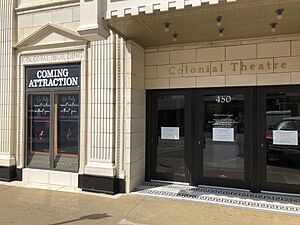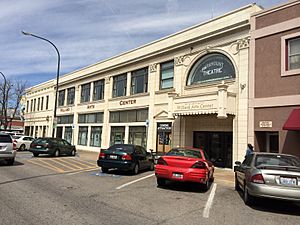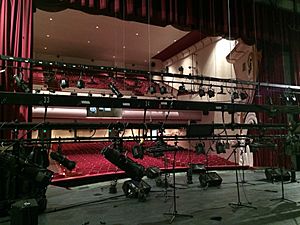Colonial Theatre (Idaho Falls, Idaho) facts for kids
The Colonial Theater is a famous old theater in Idaho Falls, Idaho. It first opened in 1919 for live shows. From 1929 to 1990, it was a movie theater called The Paramount Theater. In the 1990s, the theater was fixed up and got its original name back. Today, it is part of the Willard Arts Center. The Idaho Falls Art Council owns and runs it. Harry Brownback built the theater.
Contents
History of the Colonial Theater
After Idaho Falls changed its name in 1891, people wanted a theater. They wanted a place for vaudeville acts, traveling shows, and music. Vaudeville was a popular type of entertainment with many different acts.
In 1919, three local men helped build the Colonial Theater. They were C.A. Spath, Dr. C.M. Cline, and S.K. Mittry. It cost $175,000 to build. The theater was made of steel, concrete, and brick. It had an ivory-colored front made of terracotta. It was said to be the biggest theater in the Intermountain West. It had a space for an orchestra pit and eight dressing rooms. There were 1,400 leather seats. A ramp led to the balcony, which had 600 seats and four special box seats. The theater was built before modern sound systems. So, its design made the sound excellent.
The theater opened on November 10, 1919. The first show was a play called John Ferguson. C.H. Lewis was the first manager.
In 1929, the theater became a movie house. It was renamed The Paramount Theater. The first movie shown was Harold Lloyd's Welcome Danger in November 1929. It was a silent film, but a short comedy with sound was shown too. Through the 1960s and 1970s, the Paramount showed new movies. Ushers, who helped people find their seats, would dress up like characters from the movies. In the 1980s, it became a discount theater. By 1990, it was in bad shape and closed down. The Paramount Theater stayed empty until 1994. Some people even talked about tearing it down to build a parking garage.
Restoring the Theater
How the Theater Was Saved
In 1990, the Idaho Falls Arts Council was created. This group wanted to support art in Eastern Idaho.
In 1994, the theater's owners, Dick Clayton Sr. and Steve Clayton, gave the theater to the Arts Council. The Council started a plan to raise money to fix the theater. They called it "the Phantom project." An unknown donor, called "the Phantom," offered to match donations up to $950,000. This meant if the community raised money, the Phantom would give the same amount.
The plan worked! After three years, $4.2 million was raised. This money helped fix the Colonial Theater and nearby buildings. They became a center for visual and performing arts. The "Phantom" turned out to be a couple, Miles Jamison Willard and Virginia Willard. They also led the fundraising effort. The newly fixed complex was named the Willard Arts Center to honor them.
Discovering Old Designs
When the theater was the Paramount, many of its original designs were hidden. During the repairs, workers found what looked like the original blueprints for the Colonial Theater. They were hidden in a downstairs wall. These plans greatly helped with the restoration.
Around the same time, a local worker told the theater about a beautiful stained glass window. It was hidden under tiles above the front entrance sign. People think the window was covered in 1952. This happened after Fox Motion Picture Studios bought the theater.
Workers also pulled up old, wet carpet. They found black and white tiles running through the whole lobby. Prisoners on a work program uncovered the original 1919 Greek design. This design runs along the lobby ceiling. Arts Council staff cleaned and fixed this design. The original lights at the front of the stage were protected by Plexiglas. These were the main lights until 2014, when new lights were put in. At that time, it was decided the theater would go back to its original name, The Colonial Theatre. Live shows would be the main focus again.
On March 13, 1999, the fixed-up Colonial Theater reopened. It now had 988 seats. The first performance was by jazz musician Ray Charles.
The Colonial Theater Today
Since reopening, the theater hosts about 16 to 18 performances each year. People can also rent it for their own events. In 2014, over 25,000 people visited the Colonial Theater.
The Colonial Theater is one of only four historic theaters left in Idaho. The other three are The Egyptian Theatre in Boise, The Panida in Sandpoint, and The Virginia Theater in Shelley.




